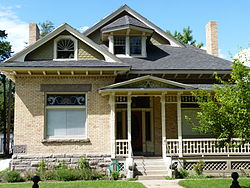Charles E. Loose House
|
Charles E. Loose House
|
|

Charles E. Loose House
|
|
| Location | 383 E. Two Hundred South Provo, Utah |
|---|---|
| Area | less than one acre |
| Built | 1893 |
| Architectural style | Stick/Eastlake |
| Part of | Provo East Central Historic District (#98000281) |
| MPS | Entreprenurial Residences of Turn-of-the-Century Provo TR |
| Designated CP | November 24, 1998 |
The Charles E. Loose House is a historic house located in Provo, Utah. The house was individually nominated for listing on the National Register of Historic Places in 1982 but was not listed due to owner objection. It later was included as a contributing property in the Provo East Central Historic District.
Built in 1893 by Charles E. Loose, the Charles E. Loose House (383 E 200 S) "Combines the massing of the Shingle Style with a consistent program of Eastlake ornamentation. Its enveloping roof, veranda and pentagonal fanlight gable windows mark its individuality among the city's architectural sites (Historic Provo p. 24)." The Charles E. Loose House was designated a historic Provo City Landmark on April 28, 1995.
Built between the years 1893 and 1908 in Provo, Utah, this group of Victorian mansions are historically significant and represent not only fine architecture but some of the most successful men of the city and state at the time. These mansions include the Charles E. Loose House, the William H. Ray House, the Knight-Allen House, the John R. Twelves House, the Jesse Knight House, the Knight-Mangum House, and the Thomas N. Taylor House. All of these homes derive from the high style: Eastlake, Shingle, Craftsman, Italianate, Classical, Moorish, Colonial, and Romanesque Revivals. Made primarily of brick, these homes exhibit the finest architecture and most ornate detailing to be found in the city of Provo.
Charles E. Loose (1853–1929) was a banker and a Utah State Senator. Charles was linked to Provo as a central entrepreneur during the period of time when Provo's economy transformed from primarily agrarian to that of commercial mining. Charles E. Loose was a non-Mormon, as opposed to many of the other primary entrepreneurs made wealthy by the tintic mining district, and probably the most prominent in Provo at the turn of the century. As Grand Central stock rose, so did Charles Loose. By 1900 the company had installed a new surface plant, including an innovative all steel headframe over its shaft—a first and only in the entire area. Thus, Loose built his Provo residence in 1893.
...
Wikipedia
